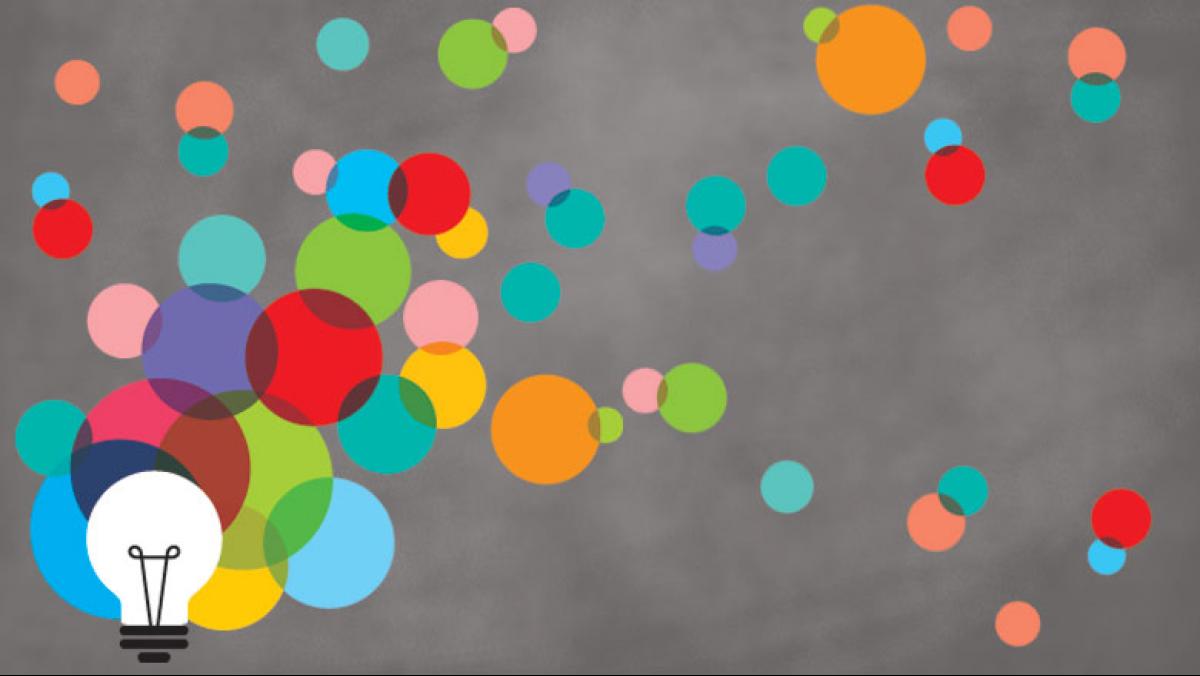Over the course of my more than 22 years as executive director of Arts Wisconsin, I have worked to place the arts and creativity at the center of life and learning throughout Wisconsin. As you can imagine, this has involved a lot of travel across the state. Travel is actually the best part of my job, because it takes me to the real issues affecting people in our communities.
One of the most important things I’ve learned in my travels is that the arts and creativity are integral to every aspect of life in our communities. There’s creativity everywhere and in all people, whether they call themselves an artist or not. But the applications for creativity go far beyond the canvas and stage. The thorny issues that arise in business, education, environment, technology, development, and recreation are often resolved through community involvement, thoughtful collaboration, imaginative processes, innovative thinking, and entrepreneurship—all things that are fueled by creativity.
For example, during the mid-2000s, Eau Claire civic leaders and residents began drawing on the power of creativity to improve life in this small city of 65,000 people. Located at the confluence of the Chippewa and Eau Claire rivers, Eau Claire had for years been a thriving industrial hub. This began to change in the 1990s, as Michelin/Uniroyal and other manufacturing plants shuttered operations across the region and people began to move away in search of better opportunities. Through a planning process called Clear Vision Eau Claire, citizens forged a public/private commitment to the arts and culture that became an important economic development strategy for the city. Today Eau Claire is gaining national attention as a small city with big-time creative opportunities and a focus on cultivating homegrown creative talent. The Milwaukee Journal Sentinel recently noted that “the bigger story is how deftly this former factory town has pivoted to embrace the arts, technology, and innovation—boosting tourism and attracting new, young transplants in the process.”
A similar success story about the power of creativity can be found in downtown Green Lake. Located on the northern shore of Green Lake in Central Wisconsin, this small resort town is in the process of adding cultural assets to a portfolio of largely recreational opportunities. Anchored by the Town Square (the former county courthouse), the Thrasher Opera House, and a regular Farmers' Market, Green Lake’s increasingly vibrant downtown provides residents and visitors alike with education, recreation, and culinary opportunities, as well as art fairs featuring local and regional artists. “We believe in community and making the most of our assets, and that working together makes and keeps us strong,” says Fran Hill, chief executive officer of Green Lake Renewal, the grassroots organization leading the downtown revitalization efforts.
What these two communities have in common is that they are both intentionally developing an arts and culture sector that generates jobs and revenue, one version of what people are calling creative economy development. We examined how Eau Claire and Green Lake are cultivating their creative economies, as well as other ways creativity can improve life in Wisconsin, during the Growing Our Creative Power series of Academy Talks. Developed by the Wisconsin Academy and presented in partnership with Arts Wisconsin, the Wisconsin Arts Board, and the League of Wisconsin Municipalities, with support from Isthmus Publishing, the series examined the elements of a creative economy that make the most sense for Wisconsin, and the ways we can harness and grow these elements to make our communities and our state stronger and more vibrant.
Presented during Fall 2016 and Spring 2017, the series of six public talks explored cultivating creative economies on the local and state levels; the power of a liberal arts education for lifelong success; the critical importance of the arts and creativity in a quality 21st-century education for all students; ways to invest in entrepreneurship, creativity, imagination, and innovation; the role of the arts in economic, downtown, and community development; and the importance of creativity in scientific exploration and discovery.
All of the organizations behind the Growing Our Creative Power series are deeply committed to creating a better future for Wisconsin. We focused our attention on creativity because we are living in an era when artistry, imagination, innovation, and entrepreneurship are directly connected to the health of our businesses, schools, communities, and individual lives.
Wisconsin, like the rest of the country and the world, is living through massive economic shifts, societal changes, and political upheavals as our once-industrial economy transitions to a 21st-century information and service economy. In Wisconsin, traditional industries—from papermaking to mining to farming—continue to be important, but new technologies and global trends are forcing these industries to evolve.
To move through the seismic economic, educational, and civic changes that surround us and to imagine a brighter future require not only building on our past but also creatively using our existing assets. Our work on Growing Our Creative Power focused on understanding what it takes to cultivate our creative capacities on the local level. We learned that this requires finding common ground and planning well but remaining open to change. Developing a creative economy in particular requires a commitment to partnership and honest collaboration (and, oftentimes, a sense of humor). As Fran Hill of Green Lake Renewal notes, this process requires “focusing on talent, ability, engagement, and a community’s unique and authentic assets.”
Through the Growing Our Creative Power series, we learned that one of the essential components of a successful creative economy is committed community members—and not just artists and designers, but also entrepreneurs, elected officials, small business owners, teachers, developers, and volunteers all working together toward a shared vision. Significantly, a greater level of commitment is often seen among citizens who have been nurtured in an education system that fosters creative thinkers.
Good creative economies also feature business incubators that value diversity, inclusivity, trust, and interactions that mix right- and left-brain people—a must for startups that want to ignite the creative spark. However, even with the right components, creative economies won’t work over time unless everyone involved is willing to take risks, potentially fail, and be willing to try again.
During the series, the Academy brought together an impressive list of speakers from across government, education, business, and nonprofit sectors. Sheila Smith, executive director of Minnesota Citizens for the Arts, kicked off the series with a discussion of how public investment in the arts and creativity provides both cultural and economic opportunity. Smith noted how this investment helps to build a sense of place on state and local levels, which in turn helps retain residents and forge stronger communities.
Certainly, public funding of the arts is a part of the creative economy mix. This kind of support reflects public values, celebrates the creative spirit, and expands access to ideas and knowledge for all. On the federal level, as of this writing, the proposed FY2018 federal budget calls for the elimination of our nation’s cultural agencies, including the National Endowments for the Arts and Humanities. This would be a devastating blow for Wisconsin and the United States. Without public investment that supports local creative endeavors and entrepreneurship, our communities could miss out on new opportunities for growth—and risk being left behind by a rapidly changing global economy.
So how can we develop creative capacity on a local level? During our series of talks, we learned that finding the resources (and not just money) to make an investment in creativity is an ongoing process. Capital projects and programs happen just like any other development project: with grassroots fundraising, public/private funds, and an entrepreneurial spirit. Our panel in “The Entrepreneurial Edge” noted that in addition to capital, all startups need workspaces that provide creative collisions. But startups also need business basics such as up-to-date technology, legal advice, and health insurance to flourish. Entrepreneur Tryg Jacobson reported on the wide range of creative startups, from forensic accounting to film editing businesses, happening at Jake’s Café in Sheboygan. The success of creative coworking communities such as Jake's Café are a good reminder that everyone can do a better job of understanding (and appreciating) how the power of creativity fuels all kinds of industry.
Unleashing the power of creativity begins with giving our students a broad-based education, one that equips them to navigate a world that increasingly values innovation and nimble thinking. The panelists in our “Raising Creative Kids” talk noted that while the arts can and should be built into K–12 programs, the roots of creativity also need to be nurtured in and out of school by making time for free play, exploration in nature, and just “messing around” without structured experiences. Reading, risk-taking, and problem-solving are habits that stoke a creative mind, according to our panelists, who noted that families and teachers can encourage these and other creative habits by nurturing a child’s sense of humor, flexibility, and self-acceptance. Indeed, part of developing what one panelist described as “fearless autonomy” is a child’s ability to debate thoughtfully with adults.
A current thrust in K–12 education is the elevation of STEAM (Science, Technology, Engineering, Arts, and Math) to give students specific content and skills necessary for success in a world that increasingly values innovation in these fields. In his talk on higher education, “The Power of the Liberal Arts,” the late Thomas Pleger described how investments in liberal arts education augment K–12 STEAM efforts. Pleger, who was president of Lake Superior State University and former campus executive officer and dean of UW–Baraboo/Sauk County, argued that students exposed to a broad cross-disciplinary education develop good communications skills, ethics, empathy, and the ability to make connections across disciplines—all skills that 21st-century citizens, leaders, and innovators need. Pleger further asserted that the real measure for return on investment in education is found not in a high-paying job but in one’s capacity for problem solving, critical thinking, and leadership.
One of the fruits of creativity in higher education is scientific discovery. In “The Art of Discovery,” four Wisconsin Academy Fellows with deep expertise in science talked about what it takes to “teach discovery.” Their discussion echoed what earlier panelists said about the power of bringing together people with different perspectives. Unique to science, however, are the concepts of embracing wonder at the complexities and beauty of living and non-living systems; exploring metaphorical thinking to reach new insights; considering how to experiment, observe, and explore in productive ways; and rewarding curiosity and questioning.
From my work on the Growing Our Creative Power series and with Arts Wisconsin, I see the ways in which cultural investment, creative development, and community strategies focused on enhancing quality of life, increasing economic opportunity, and stimulating innovative ideas are already paying off big time for the state. Seize the day, Wisconsin! Let’s do more to encourage and invest in creativity, imagination, innovation, and entrepreneurship at the local level and help move our communities forward into the 21st century.




